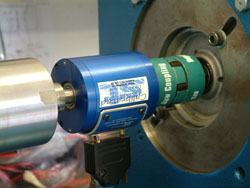
Posted to News on 6th Dec 2006, 21:31
Torque measurement on servo motors
Reliability and robustness were the key requirements when Wyko Industrial Services set about building a test and calibration rig for its servomotor repair business. The company based its design on a TorqSense non-contact torque sensor from Sensor Technology Ltd that is resistant to potentially damaging shock loads.

Wyko Industrial Services has a servo motor repair operation in Aintree, near Liverpool, and the company needed a test and calibration rig. Vic Harris, Wyko's Director for Electronic Developments, says: "We knew the rig would be in virtually constant use, so wanted to 'design out' breakdowns as far as possible. Unexpected stoppages would be disruptive to us, but potentially disastrous to our customers who often run 24 hours a day and therefore need to manage their spares and repairs with military precision."
Wyko's clients include BAE, transmission giant Ford Getrag and several of the food processing majors, alongside many smaller companies.
When motors are under test, the rig runs them against a 22kW DC spindle motor controlled by a Sprint Electric four-quadrant DC drive that is switchable between 'speed' and 'torque' modes to give both back-driving and load-testing capabilities. Back-driving is very important because it lets Wyko capture the set-up data for each servo motor before it is dismantled, which, in turn, makes recalibration quick and simple.
Non-contact benefits
Harris says he selected a TorqSense non-contact sensor, made by Sensor Technology, because it was the most advanced device he could find and its non-contact characteristic protects it from many forms of physical damage that could result from sudden load changes.
"The torque sensor is rated at 20Nm and can take 400 per cent overload, so it can cope with just about anything it is ever likely to experience on our rig. To be extra safe we have mounted it using a Fenner spider coupling on both shafts, with the rubber inserts selected to take the sting out of any unforeseen loads or sudden pressures."
The TorqSense sensor monitors the shaft under test using an RF (radio frequency) transmission head that both supplies power to and picks up signals from two tiny piezo-ceramic combs attached to the shaft. Rotational torque in the shaft contracts or stretches the combs, altering their RF emission signals in proportion to the torque experienced. In fact this arrangement utilises Raleigh waves, or surface effect waves, a physical phenomenon identified by experimental physicist Lord Raleigh over 100 years ago when he was trying to simulate and analyse earthquakes.
"Sensor Technology also supplied us with a software suite, TorqView2, which interprets the sensor's output signal in real time and presents it in easy-to-understand graphic form. It also logs and analyses the data, so we can print out a pass certificate for each tested motor."
Use the form on this page to request a callback or more information about TorqSense.
Apollo Park, Ironstone Lane
Wroxton
OX15 6AY
UNITED KINGDOM
+44 (0)1869 238400






























